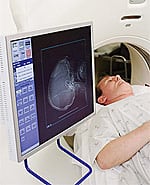Life Extension Magazine®
Metastasis is perhaps the word cancer patients dread the most—it indicates that their primary tumor has escaped its original boundaries, and that the cancer has now spread to remote parts of the body. Back in September 2007, Life Extension reported on life-saving cancer therapies that had shown their effectiveness in clinical studies, but whose approval was blocked by the FDA. One of the therapies reviewed was a diagnostic procedure available in Europe called Combidex®. This technique uses magnetic resonance imaging together with a novel contrast agent and is more effective than more invasive surgical processes for revealing small and otherwise undetectable lymph node metastases in patients with cancer. Combidex® has the power to revolutionize the diagnosis of metastatic cancer. Yet over a year since the original Life Extension article, this life-saving procedure still languishes in the FDA’s bureaucratic process. In this article, we explore how this remarkable diagnostic breakthrough is helping physicians—and patients—in their quest for early identification and tracking of metastatic lesions…while there is still an opportunity to implement aggressive therapies to eradicate the disease. Combidex®—Enhancing Images For HealthDr. Jelle Barentsz is a world-renowned radiologist and expert in the diagnostic field of functional imaging, in which specialists use a variety of methods to actually see not only what internal structures look like, but also how they are functioning. Life Extension recently caught up with Dr. Barentsz on a busy afternoon in his office at the Radboud University Medical Center in Nijmegen, The Netherlands, where he is professor of radiology and chair for research in the Department of Radiology. Dr. Barentsz’s work has been instrumental in improving oncologists’ and surgeons’ ability to recognize early lymph node metastases in patients with prostate cancer—and much of his success is related to his use of a dramatic new way to use magnetic resonance imaging, or MRI. “Worldwide, more than $40 billion is spent each year trying to track down cancer metastases, usually with studies that are unrevealing,” Barentsz says. “That often leaves patients with surgical exploration as their only option;” a costly, painful, and often ultimately unrewarding process. “Surgical exploration itself can miss up to 30-40% of metastases in prostate cancer patients,” Barentsz explains, “So there’s a compelling need for better ways to find these metastases.” His passion for improving patient care led Barentsz to his work with a revolutionary new contrast material called Combidex® (ferumoxtran-10), which is helping him and a few others locate metastases earlier and more reliably than by any other technique—including surgery. Radiologists use contrast materials routinely to help them see the differences between tissues and organs, and between healthy and diseased body parts; Barentsz and others have shown that Combidex® enhancement on MRI scanning “results in improved image quality, which may lead to improved detection of small positive lymph nodes.”1
“With Combidex®-enhanced MRI scans,” Barentsz observes, “We can pinpoint lymph nodes that have been infiltrated with cancer cells, and then direct our radiation oncology colleagues to the precise location of the diseased nodes. That gives them an unprecedented ability to deliver targeted radiation just to the cancerous tissue, reducing the total body dose of radiation and helping to minimize side effects.” This is a critical advantage, particularly in men who have already undergone treatment for prostate cancer and whose levels of the cancer marker PSA (prostate-specific antigen) have started to rise again, signaling a likely relapse. “If we can find nodes smaller than 8 mm [the size limit for other forms of imaging], we can actually improve on the performance of surgical exploration, and deliver life-saving treatment to these men at a much earlier stage in their relapse,” Barentsz says. That ability could easily make surgical exploration unnecessary, as was dramatically demonstrated in one of Barentsz’s group’s most recent studies, published in September 2008.2 The study was conducted precisely to evaluate the performance of Combidex®-enhanced MRI against the most up-to-date CT scanners, in an effort to provide an alternative to a surgical procedure. The current “gold standard” for detection of lymph node metastases in prostate cancer patients is pelvic lymph-node dissection, an invasive procedure in which the surgeon literally explores the patient’s pelvic (lower abdominal) region by hand, feeling for the telltale hard lumps that represent cancer-ridden lymph nodes. It is obvious that even the finest surgeon in the world can miss a single affected node in this arduous procedure, which carries with it considerable expense, pain, and risk of complications.3,4 Barentsz’s group tested Combidex®-enhanced MRI lymphangiography (MRL, viewing of lymph nodes and vessels) against CT for the detection of those less-than-8 mm nodes that can so easily be missed on surgical exploration. They studied 375 patients in total, from 11 hospitals in the Netherlands, all of whom had prostate cancer with an intermediate or high risk of having lymph-node metastases based on standard risk-assessment techniques. All patients had MRL plus state-of-the-art CT scans looking for those small cancerous nodes, and all patients then underwent either pelvic lymph-node dissection or a needle biopsy to confirm the diagnosis.
The researchers then compared the results of the imaging studies (Combidex® MRL and CT) with the microscopic findings of tissue removed during surgery. Sixty-one patients (16% of the total) had lymph node metastases. CT scanning detected a miserable 34% of those nodes, while Combidex® MRL identified 82%—a remarkably significant difference. Even more importantly, from the patient’s and surgeon’s standpoint, Combidex®-enhanced MRL had a negative predictive value of 96% (CT was only 88%)—this means that with a negative MRL scan result, there is less than a 4% chance of actually having a lymph node metastasis. That number is much lower than the known 30-40% of nodes that can be missed by surgical exploration itself. The study group concluded, “after a negative MRL, the post-test probability of having lymph-node metastases is low enough to omit a pelvic lymph-node dissection.” In other words, Combidex® MRL can be used instead of invasive surgery to rule out malignant metastases in prostate cancer patients! That’s a huge benefit to patients and surgeons alike. In fact, as Dr. Barentsz observes in a recently published review, the Combidex®-enhanced MRL technique “allows the detection of small and otherwise undetectable lymph node metastases in patients with prostate cancer. This has an important clinical impact, as the diagnosis will be more precise and less invasive to obtain. Subsequently, this will reduce morbidity and health care costs.”5 Combidex® MRL—Putting Magnetism to WorkWe’ll review some of the other impressive body of literature on Combidex®-enhanced scans in a moment, but first we need to take a quick look at the technique itself—how does it work, what does it do, and how safe is it? These are important questions, and mirror the questions that government agencies such as the FDA are asking. Most scientists and radiologists are convinced—but according to Dr. Barentsz, because of some bureaucratic fumbling and an inadequately designed application, FDA approval has still not been granted to this important diagnostic modality.
Dr. Barentsz is among the few European physicians allowed to use Combidex® regularly while the EU’s regulatory agencies review the data. “I’m frustrated by the slow pace of bureaucracy, both in the US and the EU,” says Barentsz during our interview. “This is a damn good contrast agent that hasn’t been properly written up for review, and the regulatory agencies have conflicting and unrealistic expectations for how it should perform. So I’m one of a handful of people fighting this uphill battle to get MRL accepted in order for us to bring improved imaging to cancer patients. I want to see more educated physicians and patients so that we can expand the benefit of these studies to more people.” We did a little exploring of our own, to better understand how Combidex® works to enhance MRI scans, and reviewed a substantial part of the rapidly growing literature on this promising and fascinating material. Let’s start with the “what is it” question. Combidex®, generically known as ferumoxtran-10, is a remarkable contrast material composed of a simple sugar compound, dextran, and an iron component named ultrasmall superparamagnetic iron oxide, abbreviated as USPIO.6 As the name might suggest, USPIO consists of extremely tiny crystals of iron (the order of 25-50 nanometers in diameter—that’s millionths of a millimeter and very close to the size of some individual molecules).6-9 At that tiny size, the iron crystals demonstrate their other vital characteristic: they become superparamagnetic, which means that individually they don’t act as magnets, but when exposed to an external magnetic field (as in an MRI scanner), they become powerfully magnetized, giving them the ability to influence the signal produced by tissue during a scan. And when USPIO crystals are injected into humans (and other animals), they are selectively taken up by scavenger cells called macrophages that are chiefly found in lymph nodes as well as other areas where inflammation is taking place.5,6 So the bottom line for Combidex® is that it goes more or less directly to where the macrophages are (lymph nodes and inflamed tissue), where it affects the appearance of just that tissue in an MRI scanner. That produces a powerful means of contrasting the macrophage-containing tissue with its surroundings—hence the term “contrast agent.”10 And since inflammation is such a vital part of so many chronic, age-related conditions, Combidex® holds the potential for dramatically improving our ability to see disease at a very high resolution in conditions as apparently diverse as cancer, atherosclerosis, multiple sclerosis, and stroke.6,11-15 What about safety? There have been a number of safety and efficacy trials of Combidex® to date, all with encouraging results. Researchers at the University of Washington School of Medicine reported one such trial in 2003, using Combidex® in 152 patients undergoing MRI imaging for diagnosis of metastases to lymph nodes.16 As with Barentsz’s own study, this group found a dramatic improvement in performance of the scans using Combidex®, and just 6% of patients reported each of the following side effects: headache, back pain, flushing, and itching. “These effects are exactly the same as one sees using standard contrast agents,” comments Dr. Barentsz, “And they all resolve rapidly when we stop the infusion.” This study’s authors also concluded that Combidex® was safe and effective.
A new safety concern about standard MRI contrast media has brought additional urgency to the study of Combidex®. Researchers in Oregon published their work on nephrogenic systemic fibrosis, a recently recognized severe complication associated with traditional MRI contrast media. It affects primarily patients with kidney disease, and can cause severe additional kidney damage. The Oregon group reported on safety studies with over 150 patients receiving Combidex®, finding that Combidex® has an excellent safety profile, even in patients with decreased kidney function.17 They concluded that USPIO agents like Combidex® are a viable option for patients at risk for nephrogenic systemic fibrosis—and that may open the door for a safer contrast medium for all patients. Combidex®—Setting the Stage for StagingLet’s turn now to the impressive clinical track record that Combidex®-enhanced scans are establishing for themselves. Because of the USPIO’s remarkable ability to be taken up by hungry macrophages, they wind up preferentially in lymph nodes, helping to “light up” these important structures and revealing both their size and their function at unprecedented resolution. Those features have made Combidex® especially useful in the vital process of staging, that is, in determining how advanced a cancer is as soon as the primary tumor has been detected.18-20 Most radiologists and oncologists agree that there is a need for more accurate staging techniques,21 because traditional imaging has relied primarily on size criteria to detect metastases, and since existing scans can’t even detect smaller, but still potentially malignant nodes, they are limited in their ability to identify early, potentially treatable, metastases.20 The use of superparamagnetic iron oxide as an MR contrast agent is actually nearly as old as MR scanning itself. In 1989, with MR scanners in use for less than a decade, radiologists at the Massachusetts General Hospital were already demonstrating their ability to identify metastases in lymph nodes of rats.22 They found a dramatic difference in the way healthy nodes appeared on scans compared with nodes containing cancerous metastases. They concluded that “MR lymphography may potentially increase the sensitivity of MR imaging the detection of lymphatic malignancy.” The following year the same researchers expanded their work, demonstrating that they could detect node metastases based on the intensity of their appearance, rather than on the less useful size criteria then in widespread use.23 A year later, this productive research group showed that they could even see minute differences in structures within lymph nodes when using the new contrast material—particularly those regions of the nodes where macrophages are found.10 By 1994, French researchers had achieved the ability to determine whether an enlarged node was benign or malignant—a vital step towards accurate staging procedures.24 It took nearly a decade for this work to be translated into human use, but in 2003 the research group at the University of Washington had completed their study of 152 adults with cancer, demonstrating a clearly improved ability to identify patients who had no metastatic nodes.16 Their ability to detect patients with dangerous metastases was also improved, but by a somewhat smaller amount—clearly work remained to be done. That work wasn’t long in appearing—in 2006, Portuguese radiologists reported a study of 20 patients with aggressive head and neck cancers, performing MR scans before and 24-36 hours after an infusion with Combidex®.25 Surgical exploration was carried out immediately following the second (enhanced) scans, to obtain actual tissue samples for comparison, with a total of 63 nodes being removed and examined. When the results were tabulated, the Combidex®-enhanced scans were shown to have identified 96% of the metastatic nodes, while the unenhanced scans only identified 64% of the metastatic nodes. Just as importantly, when a Combidex®-enhanced scan was negative, there was only a 3.2% likelihood of there actually being a malignant node, while the unenhanced scan missed 23.1%—a potentially deadly difference. The researchers strongly endorsed Combidex®-enhanced scans for nodal staging of head and neck cancers. Radiologists back in Boston confirmed and extended this success rate in a study of 169 nodes removed from 77 patients with a total of nine different malignancies.19 They concluded that Combidex®-enhanced scans alone may be adequate (instead of surgery) for lymph node characterization in these patients—though they also pointed out the importance of having an experienced radiologist interpret the scans. By early 2006, British surgical oncologists were able to publish a powerful meta-analysis (study of multiple studies) on the diagnostic precision of Combidex®-enhanced scanning for lymph node metastases.21 They evaluated a large number of high-quality published studies, and pooled the data on each study’s accuracy in identifying malignant nodes. The results are compelling and definitive: overall, the enhanced scans detected 88% of malignant nodes, and were falsely positive in only 4%; the overall accuracy (percent of times the scan “got it right”) was 96%. Compare those numbers with unenhanced MR scans, which detected only 63% of true malignancies, were falsely positive 7% of the time, and had an overall accuracy of just 84%. As we’ve seen, individual studies have now shown even better performance at correctly identifying malignant nodes—good enough performance that, in the right hands, surgeons are becoming comfortable relying on enhanced scans alone, rather than surgical exploration, to develop an accurate idea of the risk of metastatic cancer spread. Of course, those patients who do turn out to have malignant nodes will require aggressive treatment to eliminate them—often targeted radiation and sometimes surgical intervention. In such cases, Combidex®-enhanced scans are of great value to surgeons in their pre-operative planning. In a remarkable study by Dr. Barentsz’s own research group in the Netherlands, urologists compared scans done without Combidex® to those done with the contrast material, and then compared those results to findings at surgery.26 They identified 122 benign and 50 malignant nodes in 58 patients with bladder cancer. As with the studies cited above, the researchers found that Combidex® produced a dramatic increase in their ability to detect metastatic nodes, from 76% to 96%. Even more stunning, however, was the finding that metastases as small as 4 mm (less than a quarter of an inch) were identified within normal-sized nodes—nodes that, based on size criteria alone, were completely missed on the standard scan. Shockingly, the Combidex®-enhanced scan revealed nodes that were actually missed during direct surgical exploration in two patients! “Combidex-enhanced scanning in this case actually increased our ability to detect malignant nodes over the existing ‘gold standard’ of surgery,” says Barentsz in a conversation with Life Extension. “We’ve extended this in our more recent work to outperform the standard risk assessment [the so-called Roach Formula27,28] by a factor of two,” he continues. This dramatic increase in the conspicuousness of tumor-infested tissue has now been applied successfully to the evaluation of patients with cancers of the uterus,29 head and neck,25 kidney,30 breast,31 and liver;32 we can confidently expect to see its use further enhance our ability to understand the extent and severity of other cancers. | |||||||
Seeing Beyond CancerThe promise of improved tissue visualization using Combidex® is not limited to assessment of cancer and metastases. The remarkable ability of the USPIO particles in Combidex® to target macrophages means that they can, in principle, be used to identify any tissue in which these important inflammatory cells gather. That opens the door to a whole new world of functional diagnostic imaging, in which we look at how a tissue is performing in addition to simply what it looks like. We’ve learned that much of the damage caused by ischemia (lack of blood flow) during strokes and heart attacks is related to inflammation in the tissue following the return of blood flow to the area.33-35 That idea, coupled with the inflammation-sensing abilities of Combidex® scanning, caught the imagination of a team of radiologists and neurologists at Heinrich-Heine-University in Dusseldorf. Finding that even high-resolution standard MRI did not allow them to discriminate between healthy and damaged tissue in rat brains following experimentally induced strokes,36 the team went on to study a small group of humans who had undergone naturally occurring strokes.37 Using Combidex® as a “cell-specific” contrast agent, the scientists went in search of the macrophages they knew must be infiltrating damaged tissue in the stroke victims. The patients received the Combidex® infusion at the end of the first week after the stroke, and had scans done twice over the next three days. Remarkably, the researchers found that they could identify changes in both blood vessels and in surrounding brain tissue. In this way they could actually watch as the inflammation-sensing macrophages made their way from the bloodstream into the damaged tissue, accurately tracking the location and the progress of the destructive inflammatory process. This landmark study marks the first time that physicians have been able to actually watch a stroke unfold before their eyes, with unprecedented detail, and to see precisely where and how much damage was occurring!
These researchers have now extended their work to pinpoint regions of developing inflammation in patients very early in an evolving stroke.13,15 These creative scientists concluded that “[Combidex®-] enhanced MRI may help to more specifically target anti-inflammatory therapy in patients with stroke,” potentially ushering in a new age of functional treatment as well as diagnosis for this widespread condition. A less common but equally destructive condition, multiple sclerosis (MS) is also a result of inflammation in the brain, and the presence of macrophages in affected brain regions suggested the use of Combidex®-enhanced scans to French researchers in Bordeaux.11 They studied 10 patients with MS in acute relapses, conducting MR scans 24 hours after Combidex® injections. Thirty-three regions of brain inflammation were seen in nine patients, while similar regions showed up in only seven patients using conventional gadolinium-enhanced scans. The researchers concluded that Combidex® uniquely revealed cellular inflammatory events that were unfolding as the MS lesions were forming. As with the stroke studies described above, this offers a previously unheard-of ability to watch disease drama unfold—and perhaps ultimately, to administer targeted therapy. Neurologists in Amsterdam have now extended that work in patients with MS, demonstrating that they can detect more brain lesions, earlier, with a USPIO-containing contrast agent than with standard scans.38 Studying 19 patients with fluctuating levels of disease activity, they identified 188 regions of brain inflammation, 144 of which were not identified on the standard scans. Areas of enhancement with the USPIO particles were evident earlier, and lasted longer, than lesions detected on the standard scans; this behavior suggests that the USPIO-enhanced scan is much more sensitive at demonstrating activity associated with inflammation in brain tissue—the researchers even speculated that they could see signs of tissue repair on some images! Combidex®—At Risk of Becoming an “Orphan Technology?
Despite this extensive body of evidence favoring Combidex® in terms of effectiveness and safety, it is still not approved by the FDA or its counterpart in the EU. We asked Dr. Barentsz to comment on this situation. “This is an uphill battle,” he replies, “But one that I believe we can win. Physicians are notoriously slow to adopt new technologies, and frankly egos sometimes get in the way of progress. We need to get better-prepared and organized data in front of these regulatory agencies, and unfortunately they are becoming more, not less, bureaucratic over time.” Fortunately, because of his convincing studies, Barentsz himself is authorized to use Combidex® in scans at his facility in the Netherlands, and he continues to publish extensively on his successes.1,2,5,26,39 Can patients seek care voluntarily at Barentsz institution? “Yes, of course they can,” he says. “And in general I’ve found that, except for a few ‘dinosaurs,’ most surgeons and oncologists who’ve read the literature are willing to act on the results of our scans, which are read both by me and by an independent radiologist who’s familiar with the method.” SummaryThe discovery of the remarkable properties of ultra-microscopic iron particles, and their appeal to the inflammation-seeking macrophages, has opened new vistas for making functional diagnoses—diagnoses that show physicians not only the structures that comprise our bodies, but also their activities at an extraordinarily detailed level. Combidex®, the commercially produced MRI contrast-enhancing agent that contains these space-age particles, has proven its effectiveness and safety in numerous studies. The ability of oncologists to find and react to metastatic lesions previously too small or too isolated for detection will change the roadmap of cancer therapy, while neurologists and cardiologists can look forward to new ways of visualizing the destructive inflammatory changes that accompany cardiovascular disease, stroke, and other chronic conditions. There is still work to be done to achieve the widespread recognition that Combidex® deserves—the work of devoted clinician-researchers such as Dr. Jelle Barentsz is sure to achieve this in the near future. If you have any questions on the scientific content of this article, please call a Life Extension Wellness Specialist at 1-800-226-2370. | |||
| References | |||
| 1. Heesakkers RA, Futterer JJ, Hovels AM, et al. Prostate cancer evaluated with ferumoxtran-10-enhanced T2*-weighted MR Imaging at 1.5 and 3.0 T: early experience. Radiology. 2006 May;239(2):481-7. 2. Heesakkers RA, Hovels AM, Jager GJ, et al. MRI with a lymph-node-specific contrast agent as an alternative to CT scan and lymph-node dissection in patients with prostate cancer: a prospective multicohort study. Lancet Oncol. 2008 Sep;9(9):850-6. 3. Winter A, Wawroschek F. Lymphadenectomy in prostate cancer. Radio-guided lymph node mapping: an adequate staging method. Front Radiat Ther Oncol. 2008;41:58-67. 4. Hacker A, Jeschke S, Leeb K, et al. Detection of pelvic lymph node metastases in patients with clinically localized prostate cancer: comparison of [18F]fluorocholine positron emission tomography-computerized tomography and laparoscopic radioisotope guided sentinel lymph node dissection. J Urol. 2006 Nov;176(5):2014-8. 5. Barentsz JO, Futterer JJ, Takahashi S. Use of ultrasmall superparamagnetic iron oxide in lymph node MR imaging in prostate cancer patients. Eur J Radiol. 2007 Sep;63(3):369-72. 6. Corot C, Robert P, Idee JM, Port M. Recent advances in iron oxide nanocrystal technology for medical imaging. Adv Drug Deliv Rev. 2006 Dec 1;58(14):1471-504. 7. Oude Engberink RD, van der Pol SM, Dopp EA, de Vries HE, Blezer EL. Comparison of SPIO and USPIO for in vitro labeling of human monocytes: MR detection and cell function. Radiology. 2007 May;243(2):467-74. 8. Paul KG, Frigo TB, Groman JY, Groman EV. Synthesis of ultrasmall superparamagnetic iron oxides using reduced polysaccharides. Bioconjug Chem. 2004 Mar;15(2):394-401. 9. Schmitz SA, Winterhalter S, Schiffler S, et al. USPIO-enhanced direct MR imaging of thrombus: preclinical evaluation in rabbits. Radiology. 2001 Oct;221(1):237-43. 10. Lee AS, Weissleder R, Brady TJ, Wittenberg J. Lymph nodes: microstructural anatomy at MR imaging. Radiology. 1991 Feb;178(2):519-22. 11. Dousset V, Brochet B, Deloire MS, et al. MR imaging of relapsing multiple sclerosis patients using ultra-small-particle iron oxide and compared with gadolinium. AJNR Am J Neuroradiol. 2006 May;27(5):1000-5. 12. Hauger O, Grenier N, Deminere C, et al. USPIO-enhanced MR imaging of macrophage infiltration in native and transplanted kidneys: initial results in humans. Eur Radiol. 2007 Nov;17(11):2898-907. 13. Jander S, Schroeter M, Saleh A. Imaging inflammation in acute brain ischemia. Stroke. 2007 Feb;38(2 Suppl):642-5. 14. Kawahara I, Nakamoto M, Kitagawa N, et al. Potential of magnetic resonance plaque imaging using superparamagnetic particles of iron oxide for the detection of carotid plaque. Neurol Med Chir (Tokyo). 2008 Apr;48(4):157-61. 15. Saleh A, Schroeter M, Ringelstein A, et al. Iron oxide particle-enhanced MRI suggests variability of brain inflammation at early stages after ischemic stroke. Stroke. 2007 Oct;38(10):2733-7. 16. Anzai Y, Piccoli CW, Outwater EK, et al. Evaluation of neck and body metastases to nodes with ferumoxtran 10-enhanced MR imaging: phase III safety and efficacy study. Radiology. 2003 Sep;228(3):777-88. 17. Neuwelt EA, Hamilton BE, Varallyay CG, et al. Ultrasmall superparamagnetic iron oxides (USPIOs): a future alternative magnetic resonance (MR) contrast agent for patients at risk for nephrogenic systemic fibrosis (NSF)? Kidney Int. 2008 Oct 8. 18. Feldman AS, McDougal WS, Harisinghani MG. The potential of nanoparticle-enhanced imaging. Urol Oncol. 2008 Jan;26(1):65-73. 19. Harisinghani MG, Saksena MA, Hahn PF, et al. Ferumoxtran-10-enhanced MR lymphangiography: does contrast-enhanced imaging alone suffice for accurate lymph node characterization? AJR Am J Roentgenol. 2006 Jan;186(1):144-8. 20. Saokar A, Braschi M, Harisinghani M. Lymphotrophic nanoparticle enhanced MR imaging (LNMRI) for lymph node imaging. Abdom Imaging. 2006 Nov;31(6):660-7. 21. Will O, Purkayastha S, Chan C, et al. Diagnostic precision of nanoparticle-enhanced MRI for lymph-node metastases: a meta-analysis. Lancet Oncol. 2006 Jan;7(1):52-60. 22. Weissleder R, Elizondo G, Josephson L, et al. Experimental lymph node metastases: enhanced detection with MR lymphography. Radiology. 1989 Jun;171(3):835-9. 23. Weissleder R, Elizondo G, Wittenberg J, et al. Ultrasmall superparamagnetic iron oxide: an intravenous contrast agent for assessing lymph nodes with MR imaging. Radiology. 1990 May;175(2):494-8. 24. Guimaraes R, Clement O, Bittoun J, Carnot F, Frija G. MR lymphography with superparamagnetic iron nanoparticles in rats: pathologic basis for contrast enhancement. AJR Am J Roentgenol. 1994 Jan;162(1):201-7. 25. Curvo-Semedo L, Diniz M, Migueis J, et al. USPIO-enhanced magnetic resonance imaging for nodal staging in patients with head and neck cancer. J Magn Reson Imaging. 2006 Jul;24(1):123-31. 26. Deserno WM, Harisinghani MG, Taupitz M, et al. Urinary bladder cancer: preoperative nodal staging with ferumoxtran-10-enhanced MR imaging. Radiology. 2004 Nov;233(2):449-56. 27. Vargas CE, Galalae R, Demanes J, et al. Lack of benefit of pelvic radiation in prostate cancer patients with a high risk of positive pelvic lymph nodes treated with high-dose radiation. Int J Radiat Oncol Biol Phys. 2005 Dec 1;63(5):1474-82. 28. Vargas CE, Demanes J, Boike TP, et al. Matched-pair analysis of prostate cancer patients with a high risk of positive pelvic lymph nodes treated with and without pelvic RT and high-dose radiation using high dose rate brachytherapy. Am J Clin Oncol. 2006 Oct;29(5):451-7. 29. Laghi A, Paolantonio P, Panebianco V, et al. Decrease of signal intensity of myometrium and cervical stroma after ultrasmall superparamagnetic iron oxide (USPIO) particles administration: an MR finding with potential benefits in T staging of uterine neoplasms. Invest Radiol. 2004 Nov;39(11):666-70. 30. Guimaraes AR, Tabatabei S, Dahl D, et al. Pilot study evaluating use of lymphotrophic nanoparticle-enhanced magnetic resonance imaging for assessing lymph nodes in renal cell cancer. Urology. 2008 Apr;71(4):708-12. 31. Daldrup-Link HE, Rydland J, Helbich TH, et al. Quantification of breast tumor microvascular permeability with feruglose-enhanced MR imaging: initial phase II multicenter trial. Radiology. 2003 Dec;229(3):885-92. 32. Yoo HJ, Lee JM, Lee MW, et al. Hepatocellular carcinoma in cirrhotic liver: double-contrast-enhanced, high-resolution 3.0T-MR imaging with pathologic correlation. Invest Radiol. 2008 Jul;43(7):538-46. 33. Wanderer AA. Ischemic-reperfusion syndromes: biochemical and immunologic rationale for IL-1 targeted therapy. Clin Immunol. 2008 Aug;128(2):127-32. 34. Arslan F, de Kleijn DP, Timmers L, Doevendans PA, Pasterkamp G. Bridging innate immunity and myocardial ischemia/reperfusion injury: the search for therapeutic targets. Curr Pharm Des. 2008;14(12):1205-16. 35. Soriano SG, Piva S. Central nervous system inflammation. Eur J Anaesthesiol Suppl. 2008;42:154-9. 36. Schroeter M, Franke C, Stoll G, Hoehn M. Dynamic changes of magnetic resonance imaging abnormalities in relation to inflammation and glial responses after photothrombotic cerebral infarction in the rat brain. Acta Neuropathol. 2001 Feb;101(2):114-22. 37. Saleh A, Schroeter M, Jonkmanns C, et al. In vivo MRI of brain inflammation in human ischaemic stroke. Brain. 2004 Jul;127(Pt 7):1670-7. 38. Vellinga MM, Oude Engberink RD, Seewann A, et al. Pluriformity of inflammation in multiple sclerosis shown by ultra-small iron oxide particle enhancement. Brain. 2008 Mar;131(Pt 3):800-7. 39. Leenders W, Kusters B, Pikkemaat J, et al. Vascular endothelial growth factor-A determines detectability of experimental melanoma brain metastasis in GD-DTPA-enhanced MRI. Int J Cancer. 2003 Jul 1;105(4):437-43. 40. Congressional Briefing: Prostate Cancer Crisis: Early Diagnosis as a Solution. September 23, 2008. US Senate, Hart Building, Room 902. |






